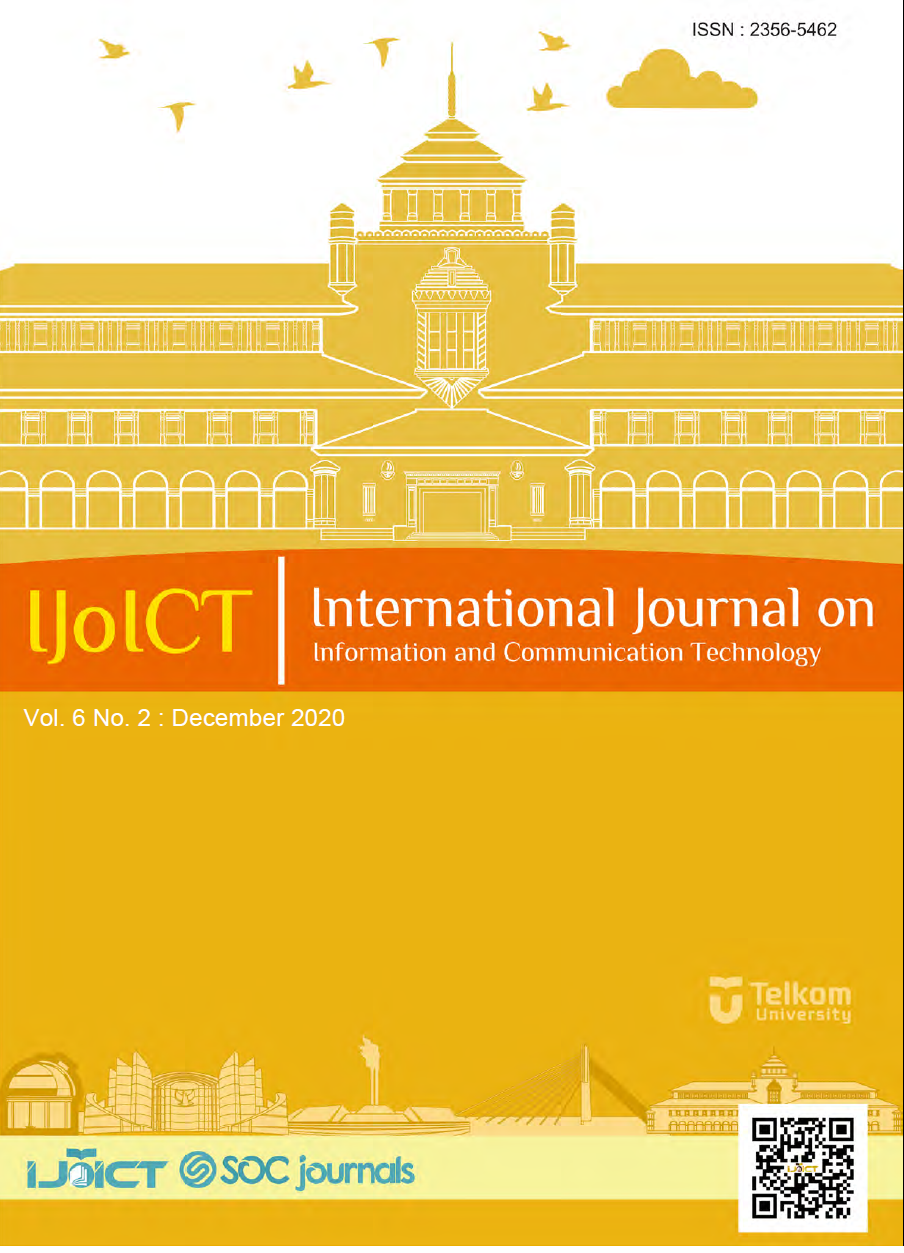Non-Line of Sight LoRa –Based Localization using RSSI-Kalman-Filter and Trilateration
DOI:
https://doi.org/10.21108/IJOICT.2020.00.495Keywords:
Localization, Object Tracking, LoRa, GPS, Trilateration, RSSI, Kalman FilterAbstract
The method that analyzes in this research is the combination of the Received Signal Strength Indicator (RSSI) with the Trilateration Method. This research also filtered the RSSI value using the Kalman filter method for smoothing data. The localization system traditionally based on Global Positioning System (GPS) device. However, GPS technology not working well in Non-line-of-sight (NLOS) like an indoor location or mountain area. The other way to implement the localization system is by using LoRa technology. This technology used radio frequency to communicate with each other node. The radiofrequency has a measurement value in the form of signal strength. These parameters, when combined with the trilateration method, can be used as a localization system. After implementation and testing, the system can work well compared with the GPS system for localization. RMSE is used to calculate error distance on these methods, the result from three methods used, the value from RSSI with Kalman filter have a close result to actual position, then value GPS follows with close result from Kalman filter, and the last one is RSSI without Kalman filter.
Downloads
References
U. Raza, P. Kulkarni, and M. Sooriyabandara, “Low Power Wide Area Networks: An Overview,†IEEE Commun. Surv. Tutorials, 2017, doi: 10.1109/COMST.2017.2652320.
D. Croce, M. Gucciardo, S. Mangione, G. Santaromita, and I. Tinnirello, “Impact of LoRa Imperfect Orthogonality: Analysis of Link-Level Performance,†IEEE Commun. Lett., 2018, doi: 10.1109/LCOMM.2018.2797057.
I. W. K. Bima, V. Suryani, and A. A. Wardana, “A Performance Analysis of General Packet Radio Service (GPRS) and Narrowband Internet of Things (NB-IoT) in Indonesia,†Kinet. Game Technol. Inf. Syst. Comput. Network, Comput. Electron. Control, 2020, doi: 10.22219/kinetik.v5i1.947.
G. Li, E. Geng, Z. Ye, Y. Xu, J. Lin, and Y. Pang, “Indoor positioning algorithm based on the improved rssi distance model,†Sensors (Switzerland), 2018, doi: 10.3390/s18092820.
R. Oliveira, L. Guardalben, and S. Sargento, “Long range communications in urban and rural environments,†2017, doi: 10.1109/ISCC.2017.8024627.
N. A. Azmi, S. Samsul, Y. Yamada, M. F. Mohd Yakub, M. I. Mohd Ismail, and R. A. Dziyauddin, “A Survey of Localization using RSSI and TDoA Techniques in Wireless Sensor Network: System Architecture,†2018, doi: 10.1109/TAFGEN.2018.8580464.
H. C. Lee and K. H. Ke, “Monitoring of Large-Area IoT Sensors Using a LoRa Wireless Mesh Network System: Design and Evaluation,†IEEE Trans. Instrum. Meas., 2018, doi: 10.1109/TIM.2018.2814082.
M. Turmudzi, A. Rakhmatsyah, and A. A. Wardana, “Analysis of Spreading Factor Variations on LoRa in Rural Areas,†2019, doi: 10.1109/ICISS48059.2019.8969846.
L. Yi, L. Tao, and S. Jun, “RSSI localization method for mine underground based on RSSI hybrid filtering algorithm,†2017, doi: 10.1109/ICCSN.2017.8230129.
L. J. Van Uffelen, B. M. Howe, E. M. Nosal, G. S. Carter, P. F. Worcester, and M. A. Dzieciuch, “Localization and subsurface position error estimation of gliders using broadband acoustic signals at long range,†IEEE J. Ocean. Eng., 2016, doi: 10.1109/JOE.2015.2479016.
M. E. Rusli, M. Ali, N. Jamil, and M. M. Din, “An Improved Indoor Positioning Algorithm Based on RSSI-Trilateration Technique for Internet of Things (IOT),†2016, doi: 10.1109/ICCCE.2016.28.
K. H. Lam, C. C. Cheung, and W. C. Lee, “LoRa-based localization systems for noisy outdoor environment,†2017, doi: 10.1109/WiMOB.2017.8115843.
G. P. Gerdan and R. E. Deakin, “Transforming cartesian coordinates X,Y,Z to geographical coordinates φ, λ, h,†Aust. Surv., 1999, doi: 10.1080/00050326.1999.10441904.
B. C. Fargas and M. N. Petersen, “GPS-free geolocation using LoRa in low-power WANs,†2017, doi: 10.1109/GIOTS.2017.8016251.
G. A. Naik, M. P. Khedekar, M. Krishnamoorthy, S. D. Patil, and R. N. Deshmukh, “Comparison of RSSI techniques in wireless indoor geolocation,†2012, doi: 10.1109/NCCCS.2012.6413008.
A. Awad, T. Frunzke, and F. Dressler, “Adaptive distance estimation and localization in WSN using RSSI measures,†2007, doi: 10.1109/DSD.2007.4341511.
É. Morin, M. Maman, R. Guizzetti, and A. Duda, “Comparison of the Device Lifetime in Wireless Networks for the Internet of Things,†IEEE Access, 2017, doi: 10.1109/ACCESS.2017.2688279.
K. H. Lam, C. C. Cheung, and W. C. Lee, “New RSSI-Based LoRa Localization Algorithms for Very Noisy Outdoor Environment,†2018, doi: 10.1109/COMPSAC.2018.10340.
M. Md Din, N. Jamil, and N. F. Nik Ahmad Aziz, “Adopting Centroid and Amended Trilateration for better accuracy of range-based non-GPS localization,†2018, doi: 10.1109/ICCOINS.2018.8510605.
A. Mackey and P. Spachos, “LoRa-based Localization System for Emergency Services in GPS-less Environments,†2019, doi: 10.1109/INFCOMW.2019.8845189.
E. Goldoni, L. Prando, A. Vizziello, P. Savazzi, and P. Gamba, “Experimental data set analysis of RSSI-based indoor and outdoor localization in LoRa networks,†Internet Technol. Lett., 2019, doi: 10.1002/itl2.75.
W. Bulten, A. C. Van Rossum, and W. F. G. Haselager, “Human SLAM, indoor localisation of devices and users,†2016, doi: 10.1109/IoTDI.2015.19.
J. Du, J. F. Diouris, and Y. Wang, “A RSSI-based parameter tracking strategy for constrained position localization,†EURASIP J. Adv. Signal Process., 2017, doi: 10.1186/s13634-017-0512-x.
K. C. Lee, A. Oka, E. Pollakis, and L. Lampe, “A comparison between unscented Kalman filtering and particle filtering for RSSI-based tracking,†2010, doi: 10.1109/WPNC.2010.5650817.
Downloads
Published
How to Cite
Issue
Section
License
Manuscript submitted to IJoICT has to be an original work of the author(s), contains no element of plagiarism, and has never been published or is not being considered for publication in other journals. Author(s) shall agree to assign all copyright of published article to IJoICT. Requests related to future re-use and re-publication of major or substantial parts of the article must be consulted with the editors of IJoICT.








.png)

.jpg)




